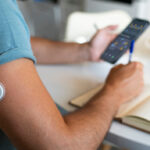
7 October 2023 | written by: Max
Diabetes sensors during exercise: advantages and disadvantages unraveled
Technological advancements have revolutionized the world of diabetes management, including the introduction of diabetes sensors. These devices offer diabetics the ability to monitor their glucose levels in real time, which can be invaluable, especially during exercise. However, as with many technological innovations, the use of diabetes sensors during exercise has both advantages and disadvantages.
Benefits of diabetes sensors during exercise
1. Continuous Glucose Monitoring (CGM):
One of the most notable benefits of using diabetes sensors during exercise is the ability to monitor real-time glucose levels. This allows athletes with diabetes to know exactly how their body responds to physical activity, allowing them to act quickly and purposefully to maintain their blood sugar levels.
2. Preventing hypo- and hyperglycemia:
Exercise can have a significant impact on blood sugar levels. With a diabetes sensor, athletes can intervene in time to prevent hypo- or hyperglycemia. This contributes to better sports performance and reduces the risk of health complications.
3. Data for optimization:
The sensors collect data about glucose levels throughout the entire sporting activity. This data can be analyzed to identify patterns and trends, allowing individuals with diabetes to optimize and better plan their exercise routine to avoid spikes and dips in blood sugar levels.

Disadvantages of diabetes sensors during exercise
1. Sensor Disturbances:
Intensive physical activity can lead to sweating and friction, which in turn can cause sensor disturbances. This can result in inaccurate measurements and potential frustration for the user.
2. Restrictions on movement:
Some diabetes sensors can impose restrictions on the wearer’s movement, especially during dynamic sports such as running or yoga. This can hinder the sporting experience and reduce enthusiasm.
3. Aesthetic considerations:
For some people, wearing a diabetes sensor while exercising may be aesthetically unpleasant. It can bring about self-consciousness and limit the choice of sportswear.

The Solution: a plaster over the sensor
To overcome the disadvantages of using diabetes sensors during exercise, a simple solution is available: applying a patch over the sensor. This strategy offers several advantages:
1. Protection against friction and sweat:
A properly placed patch provides protection against friction and thus prevents possible sensor disturbances due to sweating during exercise.
2. Improved adhesion:
A patch strengthens the sensor’s adhesion to the skin, reducing the risk of dislodgement during intense exercise.
3. Aesthetic adjustment:
With different colors and designs, plasters can be customized to personal preferences, reducing aesthetic concerns.
Conclusion
Although there are some disadvantages to using diabetes sensors during exercise, the benefits are significant and often outweigh the challenges. With simple adjustments, such as applying a band-aid over the sensor, many of the disadvantages can be minimized. It is important for people with diabetes to be aware of these technological options and adjustments to get the most out of their exercise experience while effectively managing their health. In the ongoing evolution of diabetes management, sensors offer a promising step forward, helping diabetics lead active and healthy lives.



